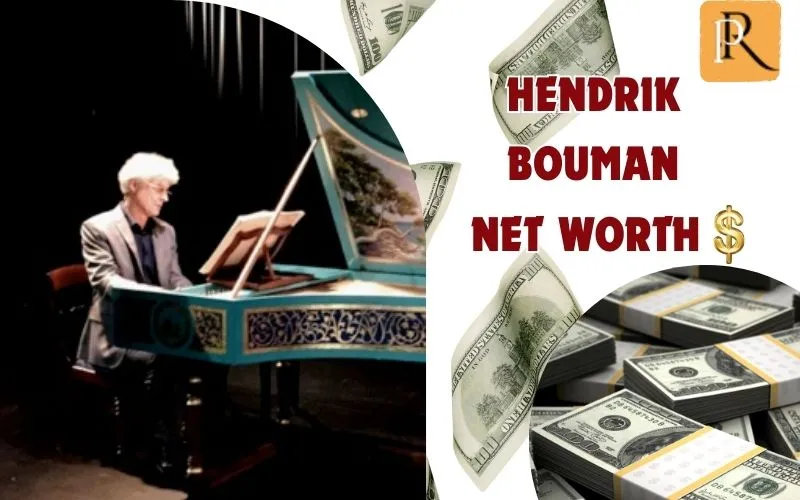Have you ever wondered about the financial success behind some of the best classical piano performers? Hendrik Bouman, a prominent figure in Baroque and Classical music, made a significant impact through his artistic prowess.
This article sheds light on Hendrik Bouman’s net worth, exploring the factors behind his lucrative career.
Quick information
| TRUTH | DETAIL |
|---|---|
| Real name | Hendrik Henk Bouman |
| Popular name | Hendrik Bouman |
| Sex | male |
| Date of birth | September 29, 1951 |
| Year old | 72 |
| Parents | do not apply |
| Siblings | do not apply |
| Place of birth | Dordrecht, Netherlands |
| Nationality | Dutch |
| Nation | do not apply |
| Education | Amsterdam Conservatory of Music |
| Marital status | do not apply |
| Sexual orientation | do not apply |
| Wife/Wife/husband | do not apply |
| Children | do not apply |
| Dating | do not apply |
| Net value | do not apply |
| Origin of wealth | Composing, performing and teaching music |
| Year of operation | do not apply |
| Category | Baroque, Classic |
| Height | do not apply |
What is Hendrik Bouman’s net worth in 2024?

Hendrik Bouman’s net worth in 2024 is not yet revealed. A renowned harpsichordist, composer and teacher, Bouman’s financial situation is not public, however his extensive career in the music industry, especially in baroque music and classic, showing the accumulation of significant wealth over many decades.
His contributions as a performer, professor, and recording artist certainly generated substantial income, supplemented by his international masterclasses and compositions.
Hendrik Bouman Full Overview and Wiki

Early life and education
Hendrik Bouman was born on September 29, 1951 in Dordrecht, Netherlands. From an early age, Bouman showed a deep interest in music, which paved the way for his later studies and a distinguished career in classical and Baroque music.
Bouman’s formal musical education began at the Amsterdam Conservatory, where he immersed himself in the study of the harpsichord under the tutelage of some of the most important figures of the Baroque renaissance.
His instructors included Ton Koopman and Lucie van Dael, who were instrumental in shaping his approach to Baroque music. In addition, Bouman expanded his musical knowledge by attending master classes led by esteemed musicians such as Gustav Leonhardt, Nikolaus Harnoncourt, and Max van Egmond.
Early career
Hendrik Bouman began his illustrious career after completing his studies at the Amsterdam Conservatory in the late 1970s, where he was taught by Baroque revival pioneers such as Ton Koopman and Lucie van Dael. .
He further honed his skills through masterclasses with Gustav Leonhardt, Nikolaus Harnoncourt and Max van Egmond.
In 1976, Bouman joined Musica Antiqua Köln as principal harpsichordist, a position he held until 1983. During this time, he toured extensively and recorded extensively, helping to bring Baroque music returned to the limelight.
Academic contributions
In addition to his performing career, Bouman was also an influential academic figure. He was a professor of harpsichord and fortepiano at Concordia University and Laval University in Quebec. His teaching repertoire includes historically informed performance practice and chamber ensembles.
Bouman was instrumental in instructing young composers in the Baroque and Classical styles, helping them master their craft. Since 2012, he has provided his expertise to masterclasses across Europe, America and India.
Innovations in performance
In 1993, Hendrik Bouman introduced Baroque improvisation at the Domaine Forge Festival in Quebec, marking a significant innovation in his approach to performance. This was followed by an introduction to his Baroque compositions in CBCTV’s 1994 broadcast of ‘Compass’ in the Canadian Maritimes.
His ability to combine historical accuracy with creative improvisation made his performances particularly engaging and unique.
Recording and broadcasting
Bouman’s discography is extensive, with 16 transcriptions of works by famous composers such as François Couperin, Jean-Philippe Rameau, Georg Philipp Telemann and JS Bach. His adaptations and stagings have been recorded by major organizations such as the Canadian Broadcasting Corporation.
His works have been featured in many live performances and broadcasts across Canada and internationally.
Conductor and Festival Director
As conductor, Bouman made his debut in 1985 with the premiere of Alain Pierard’s mass at the Basilique Notre-Dame de Montréal. He founded the classical orchestra Les Nations de Montréal, leading it in historic performances broadcast across Canada and Europe.
He is also the founding director of various music festivals and concert series, such as Baroque by the Sea and the Baroque SaMuse Concert Series, which mainly showcase his period compositions and improvisations.
Collaborate and premiere
Throughout his career, Hendrik Bouman has collaborated with many famous artists and has released a significant portion of his compositions internationally. His works have been performed in Europe, North America and beyond, demonstrating his versatility and profound influence in the field of classical music.
Social media accounts
- Facebook: Not applicable
- Twitter: Not applicable
- Instagram: Not applicable
- YouTube: Not applicable
Frequently asked questions about Hendrik Bouman

What is Hendrik Bouman known for?
He is best known for composing music in the 17th and 18th century styles, with a particular focus on baroque and early classical music.
What musical instrument does he specialize in?
He specializes in playing harpsichord, piano, clavichord and organ.
Did he compose any music for specific instruments?
Yes, he composed music for a variety of instruments including harpsichord, piano, clavichord, organ, violin, viola, flute, recorder and cello.
What styles of music does he compose?
Bouman composed primarily in the baroque and early classical styles, often reviving the musical forms and techniques of these periods.
Are there any unique themes or inspirations in Bouman’s compositions?
His compositions often reflect a deep appreciation of the aesthetic and technical aspects of the music of the period, focusing on the joy and elegance of baroque music.
How did he contribute to baroque and classical music?
Through his compositions and performances, Bouman contributed significantly to the revival and popularization of historical musical styles.
Where did he perform his compositions?
He has performed in many different countries including France, Netherlands, Belgium, England, Canada, India and South Africa.
What are some notable performances or broadcasts of Bouman’s music?
His works have been broadcast by CBC and Radio Canada, as well as on international stations such as Radio France and Radio National DT-Danish.
Does he collaborate with other musicians or bands?
Yes, he collaborated with many musicians and founded ensembles such as Concerto Felice and The Baroque Muse.
What is Bouman’s approach to music education and mentoring?
He focuses on historically based performance practice, regularly teaching and mentoring through masterclasses and workshops.
Conclusion
Understanding Hendrik Bouman’s net worth offers a fascinating look into the life of a leading classical musician. As the central figure at Da Nang Polytechnic.com, Bouman’s financial insights have inspired both budding artists and classical music enthusiasts alike. Dig deeper into what makes his story a beacon for aspiring talents in the classical music industry.
Categories: Musician
Source: dut.edu.vn






